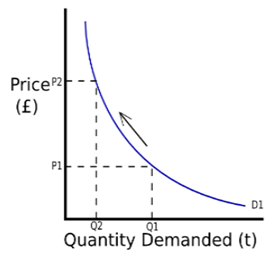What is Capital Account Convertibility and How it Affects a Country
April 3, 2025
 What is Capital Account Convertibility and How it Affects a Country
What is Capital Account Convertibility and How it Affects a Country
What is Capital Account Convertibility ? Capital Account Convertibility means that the currency of a country can be converted into foreign exchange without any controls or restrictions. In other words, Indians can convert their Rupees into Dollars or Euros and Vice Versa without any restrictions placed on them. The reason why it is called capital…
 The Great Chinese Debt Binge
The Great Chinese Debt Binge
The global financial system is in the middle of a manufactured boom. Earlier, the economies would boom on their own based on the underlying fundamentals. However, in the present scenario, the boom is 100% manufactured by central bankers that are using every trick in the book and some more to create the perception that the…
 Companies Need to Create Long Term Value to Survive the Uber Competitive Market
Companies Need to Create Long Term Value to Survive the Uber Competitive Market
The 24/7 Real Time Global Marketplace Makes Firms Live for the Moment The present global marketplace as well as regional and nations marketplaces are uber competitive and in addition, dominated and driven by rapidly changing market conditions where short term thinking triumphs and the scenario is complicated with the incessant buzz of 24/7 news cycles…
Demand for a commodity refers to the quantity of the commodity that people are willing to purchase at a specific price per unit of time, other factors (such as price of related goods, income, tastes and preferences, advertising, etc) being constant.
Demand includes the desire to buy the commodity accompanied by the willingness to buy it and sufficient purchasing power to purchase it. For instance-Everyone might have willingness to buy “Mercedes-S class” but only a few have the ability to pay for it. Thus, everyone cannot be said to have a demand for the car “Mercedes-s Class”.
Demand may arise from individuals, household and market. When goods are demanded by individuals (for instance-clothes, shoes), it is called as individual demand. Goods demanded by household constitute household demand (for instance-demand for house, washing machine). Demand for a commodity by all individuals/households in the market in total constitute market demand.
Demand function is a mathematical function showing relationship between the quantity demanded of a commodity and the factors influencing demand.
Dx = f (Px, Py, T, Y, A, Pp, Ep, U)In the above equation,
Dx = Quantity demanded of a commodity
Px = Price of the commodity
Py = Price of related goods
T = Tastes and preferences of consumer
Y = Income level
A = Advertising and promotional activities
Pp = Population (Size of the market)
Ep = Consumer’s expectations about future prices
U = Specific factors affecting demand for a commodity such as seasonal changes, taxation policy, availability of credit facilities, etc.
The law of demand states that there is an inverse relationship between quantity demanded of a commodity and it’s price, other factors being constant.
In other words, higher the price, lower the demand and vice versa, other things remaining constant.
Demand schedule is a tabular representation of the quantity demanded of a commodity at various prices. For instance, there are four buyers of apples in the market, namely A, B, C and D.
Demand schedule for apples| PRICE (Rs. per dozen) | Buyer A (demand in dozen) | Buyer B (demand in dozen) | Buyer C (demand in dozen) | Buyer D (demand in dozen) | Market Demand (dozens) |
| 10 | 1 | 0 | 3 | 0 | 4 |
| 9 | 3 | 1 | 6 | 4 | 14 |
| 8 | 7 | 2 | 9 | 7 | 25 |
| 7 | 11 | 4 | 12 | 10 | 37 |
| 6 | 13 | 6 | 14 | 12 | 45 |
The demand by Buyers A, B, C and D are individual demands. Total demand by the four buyers is market demand. Therefore, the total market demand is derived by summing up the quantity demanded of a commodity by all buyers at each price.
Demand curve is a diagrammatic representation of demand schedule. It is a graphical representation of price- quantity relationship. Individual demand curve shows the highest price which an individual is willing to pay for different quantities of the commodity.
While, each point on the market demand curve depicts the maximum quantity of the commodity which all consumers taken together would be willing to buy at each level of price, under given demand conditions.

Demand curve has a negative slope, i.e, it slopes downwards from left to right depicting that with increase in price, quantity demanded falls and vice versa. The reasons for a downward sloping demand curve can be explained as follows-
Similarly, if the price of a commodity rises, it is equivalent to decrease in income of the consumer as now he has to spend more for buying the same quantity as before. This change in purchasing power due to price change is known as income effect.
So as to get maximum satisfaction, an individual purchases in such a manner that the marginal utility of the commodity is equal to the price of the commodity. When the price of commodity falls, a rational consumer purchases more so as to equate the marginal utility and the price level.
Thus, if a consumer wants to purchase larger quantities, then the price must be lowered. This is what the law of demand also states.
The instances where law of demand is not applicable are as follows-
The more expensive these goods become, more valuable will be they as status symbols and more will be there demand. Thus, such goods are purchased more at higher price and are purchased less at lower prices. Such goods are called as conspicuous goods.
For instance, potatoes, animal fat oil, low quality rice, etc. An increase in price of such good increases its demand and a decrease in price of such good decreases its demand.
Consumers tend to purchase less or tend to postpone the purchase if they expect a fall in price of commodity in future. Similarly, they tend to purchase more at high price expecting the prices to increase in future.
Your email address will not be published. Required fields are marked *